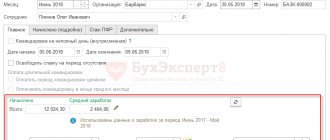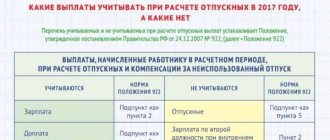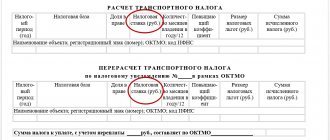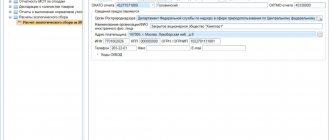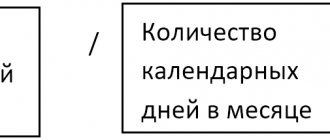Vacation payments and compensation - all about how to calculate the real amount. Examples of calculations of vacation pay for quitters, women on maternity leave, and when wages change. How can employers cheat in providing what they are entitled to? And what rights does an employee have to vacation and vacation pay in general? All details about calculation, indexation, employee rights and compensation for non-use of rest days.
Rules and length of service for vacation and calculation of vacation pay
There are certain provisions governing when an employee goes on vacation and the accrual of payments to him during his vacation. Everything must be taken into account so as not to accidentally violate the law and not disadvantage the employee.
New 2022 rules for calculating holiday pay
The system for calculating the amount due to an employee upon retirement for 28 (or more) days has long been established. In 2022, no new rules for calculating vacation pay have been created. As before, the process is regulated by Article 139 of the Labor Code of the Russian Federation and paragraph 4 of Decree of the Government of the Russian Federation of December 24, 2007 No. 922. The formula remains as follows:
Vacation pay = Average earnings per day * Number of vacation days
As before, when calculating vacation pay, it is necessary to take into account all the employee’s income related to the remuneration system. That is, wages, allowances, bonuses and additional payments. There is no need to take into account amounts assigned other than wages (for example, financial assistance or sick leave).
How long do you need to work for vacation?
In order to obtain this right, an employee must continuously work in the organization for at least 6 months. After this, he can request the standard 28 days for rest, or split this period into two or more parts.
The length of service includes only time worked under an employment contract. If an employee worked under a civil contract, then this time is not taken into account in the length of service. That is, such an employee does not have the right to leave until he switches to an employment contract and works under it for six months.
The following have the right to receive leave without working for 6 months (“in advance”) without the consent of the employer:
- minors;
- those who are going on maternity leave or have just returned from it;
- who have adopted a child under 3 months of age.
Other employees can also go on vacation “in advance,” but this will require an agreement with the employer. But you can only get annual paid leave in this way - other types (educational, maternity leave, etc.) are assigned only upon presentation of the relevant document.
At the same time, at any time convenient for the employee, leave can be taken by:
- husbands if their wives are on maternity leave;
- veterans and “Chernobyl victims”;
- husbands/wives of military personnel;
- part-time workers, provided that they also received vacation at their second job;
- heroes of the USSR, Socialist Labor, Russian Federation, holders of the Order of Glory or Labor Glory (full);
- honorary donors of the Russian Federation;
- exposed to radiation during testing of nuclear weapons at the Semipalatinsk test site;
- working in the Far North (or in regions equivalent to it), provided that they accompany a minor to enter a university or college in another region.
Attention! When calculating length of service, not the calendar year, but the working year is taken into account. If an employee was hired by the organization on March 1, 2018, then only on September 1, 2022 (after 6 months from hiring) he gets the opportunity to go on vacation.
Formulas for calculating vacation pay in 2022
To calculate vacation pay, use the following formulas.
- The billing period has been fully worked out:
29.3 days - the approved number of days in a month (Resolution of the Government of the Russian Federation of July 10, 2014 No. 642).
2. The billing period has been partially worked out or there are excluded periods:
Formula for calculating vacation pay:
Average daily earnings x Number of vacation days
Before transferring vacation pay, personal income tax must be withheld. It is important to transfer payments on time:
- vacation pay - 3 days before the start of the vacation
- Personal income tax on the day of payment of vacation pay.
Employee's rights to leave
Every employee has the right to rest. It must be provided by the employer every year and paid in accordance with the law. This right does not depend on where a person works, how his place of work is organized, and so on. Moreover, both an ordinary employee and a part-time employee, a seasonal worker and any other can take advantage of the leave. Except for those who have entered into a civil contract with the employer (for example, a contractor).
The right to maintain a position and average earnings
One of the main responsibilities of an employer to an employee going on vacation is to maintain his level of earnings and position. The boss does not have the right to send an employee on a walk without paying him vacation money (based on average earnings), or to fire him while he is on vacation.
It is worth remembering that vacation at your own expense is not paid for by the employer. If the period exceeds 14 days, all subsequent days away from the workplace will not be included in the length of service required to take a well-deserved annual rest.
Right to use vacation
An employee has the opportunity to rest for 28 days after working for at least 6 months for one organization. He can take it at any time after six months of accrual of experience, without violating the approved vacation schedule. But you can take time off “in advance” (before reaching six months), if the employer agrees to this.
In the case when a person works part-time, he has the right to receive leave from both jobs at once in accordance with Art. 286 Labor Code of the Russian Federation. Even if he has not been on one of them for 6 months yet, in this case the boss must provide the rest “in advance.”
An employee cannot be recalled from vacation if he does not agree to it. If agreed, the “non-time off” days still remain with the employee, and in the event of dismissal, the employer must compensate for them. In addition, even if the employee wishes, the following categories of citizens cannot return from vacation earlier:
- minors;
- pregnant women;
- working in dangerous or harmful conditions.
It is worth remembering that according to Art. 114 of the Labor Code of the Russian Federation, annual paid leave is not only an employee’s right. This is his direct responsibility. You can't refuse a vacation. It can be transferred to the next calendar year at your own request (in some cases regulated by the Labor Code of the Russian Federation and internal regulations of the organization). But only once - you can’t not go on vacation twice in a row. The employer has the right to consider a voluntary refusal to take leave a disciplinary violation and apply appropriate sanctions to the employee.
In this case, annual leave can be divided into two parts (or more, if the number of days allows) so that one of them is at least 14 days.
Right to extend leave
In some cases, the employee has the opportunity to slightly increase the rest period. Such situations include:
- Illness during vacation (if confirmed by a sick leave certificate, does not apply to the illness of an employee’s child).
- Performing government duties while on vacation.
You can also obtain permission for additional days of rest in other situations provided for by law and internal agreements/regulations of the organization. The list of such situations still remains open, so it is worth checking with the employer about a specific precedent.
Duration of vacation
The usual length of leave is 28 days. In this case, the employee, having agreed on his wishes with the employer, has the right to divide his vacation into several parts. It is important to remember that one of these parts must be at least 14 days (Read also the article ⇒ Vacation in working days in 2022 (an example of calculating vacation in working days)).
Vacation is counted in calendar days, and it does not matter whether weekends fall within this period.
Important! An employee can extend his vacation only due to holidays that fall during his vacation period.
| ★ Best-selling book “How to calculate vacation pay” (120 pages, practical examples, formulas and complex cases) > 3000 books purchased |
Compensation for unused vacation
In some cases, an employee has the right to receive money instead of vacation directly (or part thereof). But not all of them. It is impossible not to go on vacation, receiving instead a certain amount in addition to your salary.
An employee may request money in lieu of vacation if he:
- He quit without taking the required time off (Article 127 of the Labor Code of the Russian Federation).
- He does not want to rest for more than 28 days and is ready to write a statement so that the remaining vacation days are replaced with money (Article 126 of the Labor Code of the Russian Federation). But only on the condition that the annual leave is more than 28 days, and the employee is an adult and not a pregnant woman.
Employees who have worked for at least 11 months without a 28-day vacation can count on full compensation upon dismissal. Moreover, if the vacation was postponed, you must work 23 months to receive compensation for 56 days. But, if an employee is discharged as a result of entering active military service or due to a reduction, liquidation or suspension of the enterprise, its reorganization, then the minimum threshold for receiving full compensation for 28 days is reduced to 5.5 months. To receive money for 56 days, such an employee must work 18 months with the transfer of vacation from the first year.
If the employee worked for less than 11 months and quit for any other reason, then he has the right to proportional compensation according to the months worked. To do this, you need to divide the number of vacation days by 12 months.
When calculating length of service, just as in the case of obtaining the right to leave, working months/years are taken into account, not calendar ones. That is, to obtain the right to 100% compensation, 28 days in case of dismissal must be worked, for example, from March 1, 2022 to February 1, 2019 (11 months).
The second option covers almost all citizens with extended or additional leaves - be they for disability, seasonal (teachers) or for other reasons. Only “Chernobyl victims” and those working in harmful/dangerous conditions are not subject to this rule (additional leave).
In addition, two annual holidays cannot be combined to obtain compensation for anything greater than 28 days. Because each of them is taken into account separately. But if both exceed 28 days (let’s say 32 days each), then you can request to pay an additional 4 days from each period. But this right of the employee is not the obligation of the employer. Therefore, the latter has the right to refuse payment of money and send the applicant to “walk” for the prescribed number of days.
Attention! You cannot receive compensation for a vacation of no more than 28 days (even if it was not taken last year) in money! This is a serious violation that will lead to a fine for the employer under Part 1 of Art. 5.27 Code of Administrative Offenses of the Russian Federation.
Salary indexation
During the billing period, the employee's salary could be indexed. This is required by labor legislation. When calculating average daily earnings, the indexation coefficient should also be taken into account. It is determined by dividing the amount of salary after the increase by the amount of salary before indexation.
For example, from January to October (ten months) an employee had a monthly salary of 20,000 rubles. Then the salaries were increased, and the employee began to receive 25,000 rubles in November and December (two months). The indexation coefficient is 1.25 (25,000 rubles: 20,000 rubles). The calculation of average daily earnings will be as follows:
(10 months × 20,000 rub. × 1.25 + 2 months × 25,000 rub.) : 12 months. × 29.3 = 853.24 rub.
If the employee’s vacation is 28 days, he needs to be paid 23,890.78 rubles. (RUB 853.24 × 28 days).
How employers cheat with vacation
In connection with the crisis, organizations and entrepreneurs often seek to reduce costs for employees, getting maximum output from them. In this case, illegal methods are often used. How to avoid being deceived when calculating vacation pay or vacation?
Failure to provide full leave
An employer may not send an employee on vacation at the time allotted to him (according to the application and/or schedule), especially if the employee has not worked the full pay period. The authorities may motivate this by the fact that he has not yet “earned” a full term.
This is not true. After 6 months of continuous work, according to Art. 122 of the Labor Code of the Russian Federation, a person already has the right to a full 28-day rest.
Incomplete payment of vacation money
In some cases, management may try to save on vacation pay by paying only part “upfront” and the other part later. This is an illegal decision, since the full amount due to the employee going on vacation must be paid at least three days before the start of the vacation.
According to Art. 124 of the Labor Code of the Russian Federation, even if part of the money has not been paid, the employee has the right to demand that annual paid leave be postponed. But at the same time, the employer can pay vacation pay in installments, starting long before the employee’s rest time.
Payment of part of the vacation pay after the start of the vacation is allowed only in one case - if the employer is not yet able to calculate the exact amount (for example, if part of the employee’s exact earnings for the last working month is not yet known, since the vacation begins on the 1st day of the new month).
No indexation of vacation pay in case of salary increase
An organization may simply “forget” to index the average salary for the billing period if the salary was raised. But, according to clause 16 of the Decree of the Government of the Russian Federation of December 24, 2007 No. 922, when rates are increased in the cases provided for in the clause, it also entails a recalculation of vacation pay.
Accountants especially suffer from such “forgetfulness” in relation to women on maternity leave. And this is a direct violation of Art. 132 of the Labor Code of the Russian Federation, being an infringement in the field of remuneration
Deadlines for transferring vacation pay
Current legislation determines that a business entity must transfer to its employee who is going on vacation the calculated amount of vacation pay no later than 3 days before the start of his vacation.
In a situation where the designated day of transfer will act as a weekend or holiday, moving it forward is prohibited. If this occurs, you need to perform the transfer in advance.
When an employee has written and submitted an application for leave immediately before the desired date of departure, the law allows the company to calculate and issue vacation pay amounts within 3 days from the date of registration of the said application.
It is strictly forbidden to violate the deadline for paying vacation pay in order to issue it along with an advance payment or salary.
Also, the law does not specify an upper limit for the transfer of vacation pay. Thus, the organization can calculate and issue this amount in advance, without waiting for the assigned 3 days to arrive. For example, this can be done 2 weeks in advance, immediately notifying the employee about the upcoming vacation.
If it is expected that the employee will soon leave the organization due to dismissal, or he will be laid off, it is still prohibited to transfer the payment.
In this situation, vacation pay must be issued no later than 3 days before going on vacation, and the remaining transfers must be issued at the time specified for them. For example, compensation for unused vacation upon dismissal - on the final day of work.
The legislation defines fines for cases when a business entity does not comply with the deadlines for issuing vacation pay.
Their size is set:
- from 30 to 50 thousand rubles - for an organization;
- from 10 to 12 thousand rubles - for a responsible official;
- from 1 to 5 thousand rubles - for an entrepreneur.
Attention! If this is not the first time an employer has violated deadlines, and has previously been punished for this, then the amount of penalties imposed on him can be significantly increased.
How to correctly calculate vacation pay: calculation examples
To get the total amount that the organization is obliged to pay to the employee before his leave, it is necessary to calculate the average earnings. It includes all types of payments, regardless of their sources - additional payments, bonuses for labor, bonuses for length of service and conditions, and so on. You can get it from the actual time worked and wages for the last 12 calendar months.
The calculation of vacation pay does not take into account sick leave and payments for disability, travel allowances, financial assistance, compensation for wages and food.
So, to get the amount of vacation pay, you need to carry out several manipulations. For example, in the calculations, let’s take an employee who was not sick and did not take vacation at his own expense, and whose average annual earnings (AE) is 360 thousand rubles.
To begin with, calculate the employee’s average monthly earnings (ASM). To do this, earnings for the year must be divided into 12 months. In formula form it looks like this:
SMZ = SZ / 12
where, SMZ is the average monthly salary of an employee ; SMZ is the average salary for the year
SMZ = 360,000 / 12 SMZ = 30,000 rubles.
Now that the average monthly earnings are known, we can calculate the employee’s average daily earnings. To do this, you need to divide the SMZ by a factor of 29.3 (the average number of days in a month):
SDZ = SMZ / 29.3 SDZ = 30,000 / 29.3 SDZ = 1023.89 rubles.
where, SDZ is the employee’s average daily earnings
That is, an employee earns almost 1,024 rubles per day. Now, in order to calculate the amount of vacation pay (OTP) due to him, you need to multiply this amount by the number of days of vacation (Days):
OTP = SDZ * Days OTP = 1023.89 * 28 OTP = 28668.92 rubles.
where, OTP is the amount of vacation pay
An employee who goes on vacation after honestly working 12 months will receive exactly this amount of vacation pay.
It is worth remembering that vacation pay must be paid no later than three calendar days before the first day of rest. This includes weekends and holidays. In this case, vacation pay is necessarily taxed!
In case the employee has not worked for 12 months
Sometimes it happens that an employee wants to go on vacation without working the full pay period (12 months by default). In this case, the employee did not work out the entire pay period. And it is necessary to calculate his vacation pay based on the number of calendar days he worked. For example, a person worked for 6.5 months (KM) and during this time received 195 thousand rubles (SZ).
It is necessary to calculate how many days the employee worked in full months (DPM). To do this, you need to multiply the fully worked months (OM) by the average number of days in them (the generally accepted coefficient is 29.3):
DPM = OM * 29.3 DPM = 6 * 29.3 DPM = 175.8 days.
where, DPM is the number of days worked in full months
After this, you need to find out how many days the employee worked in an incomplete month (DNM). To do this, it is necessary to divide the coefficient 29.3 by the total number of days in the month not fully worked (CD) and multiply by the number of days worked in the month (ODM). Let's say an employee worked half of February in a non-leap year.
DNM = 29.3 / CD * ODM DNM = 29.3 / 28 * 14 DNM = 14.65 days.
where, DNM is the number of days worked in an incomplete month KD is the total number of calendar days of this month ODM is the number of days worked in the month
Now it’s time to calculate how many days the employee worked in total (OD). To do this, you need to add up both of the resulting results - days in full (DPM) and incomplete (DNM) months.
OD = DPM + DNM OD = 175.8 + 14.65 OD = 190.45 days.
where, OD is the sum of days worked
After this, it is enough to calculate the average daily earnings (ADE). To do this, in this case, you need to divide your earnings for 6.5 months by the number of days worked:
SDZ = 195,000 / 190.45 SDZ = 1023.89 rubles.
where, SDZ - average daily earnings
And multiply the average daily earnings by the number of vacation days (Days, standard - 28 days) to get the amount of vacation pay (OTP):
OTP = SDZ * Days OTP = 1023.89 * 28 OTP = 28668.92 rubles.
where, OTP is the amount of vacation pay
The employee must receive this amount when going on vacation, provided that he has worked an incomplete pay period. Using the same principle, you can recalculate vacation pay for those employees who were sick or on unpaid leave. It is enough to recalculate each month in which days were missed, using the formula for DNM, and add the results obtained with the number of days in fully worked months.
Upon dismissal
If an employee does not take his allotted leave upon dismissal, he has the right to compensation for this time in cash.
Let's say an employee worked for 11 months, after which he decided to quit. At the same time, he did not go to rest. In this case, the amount of compensation (AC) is calculated based on the average daily earnings (ADE) for the billing period, multiplied by the number of non-vacation days (ND).
Let’s say an employee who has worked for two years resigns, transferring the rest from the first year to the next. In this case, he is entitled to 56 days of vacation. During the last billing period, he earned 360 thousand rubles (according to the calculations above, he receives 1023.89 rubles per day). Then you will need to pay:
SK = SDZ * ND SK = 1023.89 * 56 SK = 57337.84 rubles.
where, SK - amount of compensation ND - number of days not taken off
Such compensation is due to a person who has never taken a vacation in two years and decided to quit.
Maternity and annual leave
Maternity leave can be combined with annual leave, combining them in two options:
- First annual, then immediately – sick leave for pregnancy and childbirth, followed by maternity leave.
- Immediately after the end of parental leave for a child under 3 years of age, the annual leave begins. But in this case, the period of parental leave is reduced to 1.5 years.
In both cases, the amount of vacation payments is calculated in exactly the same way as for planned annual leave.
Even if it was taken after maternity leave, the amount of vacation payments must be calculated based on the average salary of the last working (not maternity leave!) year. Therefore, it makes no difference in what combination you use maternity leave and vacation - the amount will be the same. The only difference is time.
When salary changes
If the company’s salary was raised before the employee’s vacation, it is necessary to recalculate the average earnings on the basis of which vacation pay is calculated.
First you need to calculate the salary increase factor (SIC). To get it, you need to divide the new salary (NO) by the old one (SO). Let’s assume that the employee’s old salary was 25,000 rubles, and the new one was 30,000 rubles. In this case, the coefficient will be as follows:
KPO = NO / SO KPO = 30000 / 25000 KPO = 1.2
where KPO is the salary increase coefficient
After this, you can recalculate (index) the employee’s average earnings. There are three options:
- The salary increased in the billing period (RP). In this case, you need to multiply all payments from the beginning of the RP to the month in which the salary increased by the resulting KPO coefficient.
- The salary increased after the end of the pay period, but before the first day of vacation. The entire average salary of the RP is multiplied by a coefficient.
- The salary increased when the employee had already gone on vacation. The portion of vacation pay remaining at the time of introduction of new salaries is multiplied by a coefficient.
After indexing according to one of the three options, you will get the exact amount of vacation pay that the employee going on vacation should receive.
Calculation of vacation pay taking into account sick leave and absences
During the billing period, each employee could be on sick leave or on vacation at his own expense, or go on a business trip. These periods should be subtracted, that is, the above formula should be slightly transformed.
For example, your employee was sick from April 2 to April 12, 2022. There are only 30 days in April, which means he worked 19 days in April. Thus, the average number of days in April for this employee will be 18.55 (29.3 days : 30 days × 19 days). In all other eleven months, the average number of days is standard (29.3).
We substitute the result obtained for April into the above formula to obtain the value of the employee’s average daily earnings:
SDZ = ZP: (11 × 29.3 + 18.55).
Similarly, it is necessary to calculate the SDZ for business trips and other cases when the employee retained his average earnings, and he was also on vacation at his own expense.
How are vacation rates, allowances, bonuses, sick leave, etc. taken into account when calculating vacation pay?
During the billing period, they will take into account not only the actual time that the citizen worked, but also the time spent by the employee on:
- Passing a medical examination. If an employee was forced to undergo a medical examination instead of performing his direct job duties, this does not mean that this time will not be counted towards work.
- Health recovery. The sick period does not give the employer the right to dismiss an employee, so he retains his job. Sick leave time is also included in the working period.
- Other purposes, if work was not absenteeism and the employee was assigned a workplace.
Time is not taken into account when calculating if the employee:
- Received temporary disability benefits.
- Received benefits related to maternity leave and pregnancy.
- He was sent on vacation due to the fault of his employer. For example, the employer did not provide a workplace or did not organize proper working conditions.
- I was unable to work due to a strike.
- Spent time caring for a disabled person.
- He was released from work according to the legislation of the Russian Federation.
The amount of vacation payments is also affected by the number of rates or the number of salaries that the employee received. Salaries depend on them.
Payments also taken into account:
- Premium.
- Surcharges for borrowing rates.
- Additional payments according to established tariffs. For example, for night shifts.
- For qualification.
- By length of service.
- For working in difficult working conditions. For example, at an industrial enterprise that is dangerous to human life and health, or in the North.
Let us note which payments will not be considered when calculating compensation for vacation:
- Business trips.
- Congratulations. For example, the team decided to raise funds and congratulate a colleague on his anniversary by donating money. Donated money will not be counted as income.
- Pension.
- Disability benefits.
- Payments necessary for the implementation of a work order. For example, a company needs to purchase 10 folders. Funds are allocated for this. An employee does not have the right to spend money for his own purposes. They will not be considered income.
- Social benefits, financial assistance.
- Incentive. If an employee wins money, it will not be considered income.
- Transport.
- Spent on buying groceries or going to the canteen during a business trip.
- Payments necessary for the purchase of work clothes, shoes, hygiene products, etc.
- Spent on buying tickets on vacation, food.
- Hospital expenses.
You should not think that income and working period will include all cash receipts to the employee. We have noted all the important and most common payments that can be taken into account when calculating.
If you have doubts or other questions, you can ask them to an accountant or our lawyer on the website. A highly qualified specialist will explain to you what period of your work - or, conversely, disability - will be taken into account when calculating vacation pay.
Working hours standards for 2022
By number of working days
| Month or Quarter or Year | Amount of days: | ||
| calendar | workers | weekend | |
| January | 31 | 17 | 14 |
| February | 28 | 19 | 9 |
| March | 31 | 20 | 11 |
| April | 30 | 21 | 9 |
| May | 31 | 20 | 11 |
| June | 30 | 20 | 10 |
| July | 31 | 22 | 9 |
| August | 31 | 23 | 8 |
| September | 30 | 20 | 10 |
| October | 31 | 23 | 8 |
| November | 30 | 21 | 9 |
| December | 31 | 21 | 10 |
| 1st quarter | 90 | 56 | 34 |
| 2nd quarter | 91 | 61 | 30 |
| 3rd quarter | 92 | 65 | 27 |
| 4th quarter | 92 | 65 | 27 |
| 2018 | 365 | 247 | 118 |
By number of working hours
| Month or Quarter or Year | Working time (hours) | ||
| 40 hours/week | 36 hours/week | 24 hours/week | |
| January | 136,0 | 122,4 | 81,6 |
| February | 151,0 | 135,8 | 90,2 |
| March | 159,0 | 143,0 | 95,0 |
| April | 168,0 | 151,2 | 100,8 |
| May | 159,0 | 143,0 | 95,0 |
| June | 160,0 | 144,0 | 96,0 |
| July | 176,0 | 158,4 | 105,6 |
| August | 184,0 | 165,6 | 110,4 |
| September | 160,0 | 144,0 | 96,0 |
| October | 184,0 | 165,6 | 110,4 |
| November | 168,0 | 151,2 | 100,8 |
| December | 168,0 | 151,2 | 100,8 |
| 1st quarter | 446,0 | 401,2 | 266,8 |
| 2nd quarter | 487,0 | 438,2 | 291,8 |
| 3rd quarter | 520,0 | 468,0 | 312,0 |
| 4th quarter | 520,0 | 468,0 | 312,0 |
| 2018 | 1973,0 | 1775,4 | 1182,6 |
Standard working hours in the production calendar
The standard working time is the number of hours that an employee must work in a period: month, quarter, year. There are 365 days in 2022. With a 5-day work week, there are 247 working days and 118 weekends and holidays. With a 6-day work week - 299 workers and 66 non-workers. Working time standards are:
- — for a 40-hour work week 1970 hours;
- — for a 36-hour work week 1772.4 hours;
- — for a 24-hour work week 1179.6 hours.
You will find quarterly and monthly standards in our tables - appendices to the production calendar. Working standards are prescribed in the employment contract, job descriptions and labor regulations.



